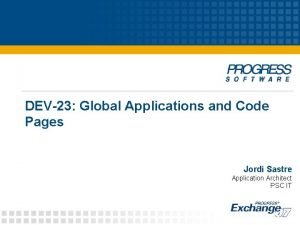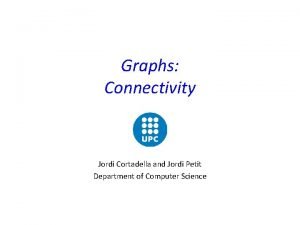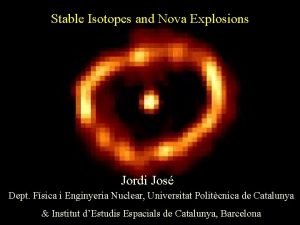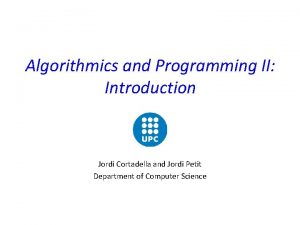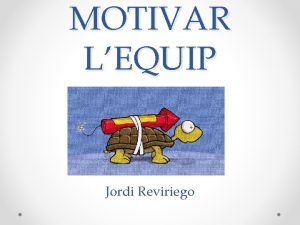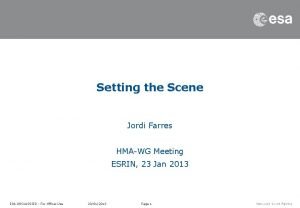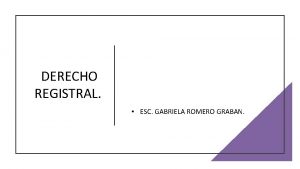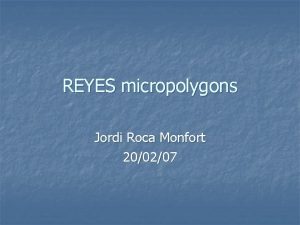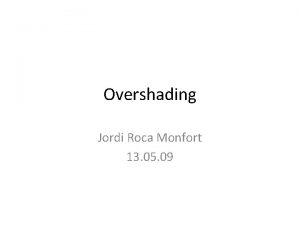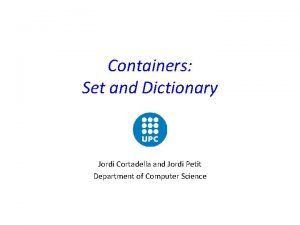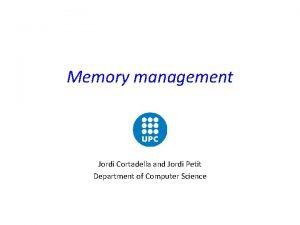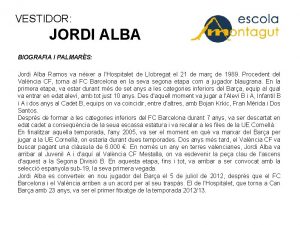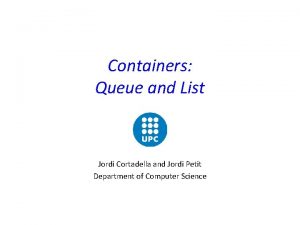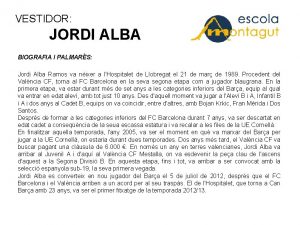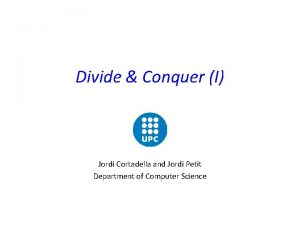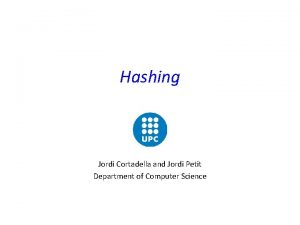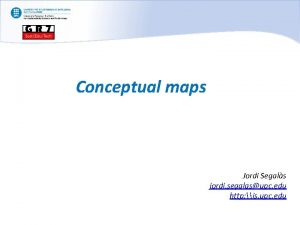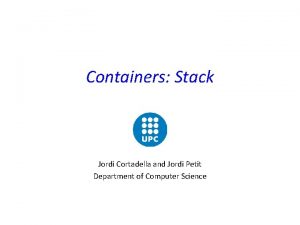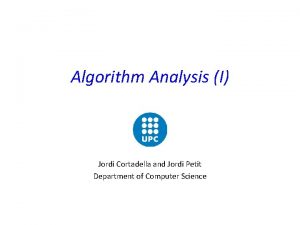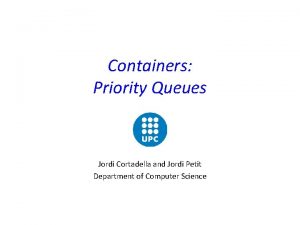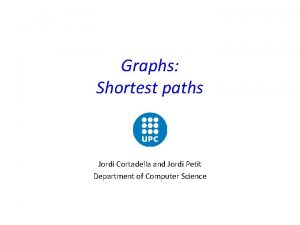Workload Characterization of 3 D Games Jordi Roca



























- Slides: 27

Workload Characterization of 3 D Games Jordi Roca, Victor Moya, Carlos González, Chema Solis, Agustín Fernandez and Roger Espasa (Intel DEG Barcelona) Computer Architecture Department 1

Outline • Introduction • Game selection & stats gathering • Game analysis – System → GPU traffic – Primitive culling efficiency – Rasterization pipeline – Fragment shading & texturing – Memory usage • Conclusions 2

Introduction • Games and GPU evolve fast • GPUs cater for game demands: – Better effects (flexible programming models) – Higher fill-rate (more processing power) – Higher quality (HDR, MSAA, AF) • Games highly tuned to released GPUs • New characterization needed for every Game and GPU generation. 3

Outline • Introduction • Game selection & stats gathering • Game analysis – System → GPU traffic – Primitive culling efficiency – Rasterization pipeline – Fragment shading & texturing – Memory usage • Conclusions 4

Game workload selection Game/Timedemo Frames Duration Aniso Graphics Texture Quality Shaders at 30 fps Level API Engine Release Date Open. GL Unreal 2. 5 Mar 2004 Open. GL Doom 3 Aug 2004 Open. GL Doom 3 Oct 2005 Open. GL Starbreeze Dec 2004 Direct 3 D Monolith Oct 2005 UT 2004/Primeval 1992 1’ 06” High/Aniso 16 X NO Doom 3/trdemo 1 3464 1’ 55” High/Aniso 16 X YES Doom 3/trdemo 2 3990 2’ 13” High/Aniso 16 X YES Quake 4/demo 4 2976 1’ 39” High/Aniso 16 X YES Quake 4/guru 5 3081 1’ 43” High/Aniso 16 X YES Riddick/Main. Frame 1629 0’ 54” High/Trilinear - YES Riddick/Prison. Area 2310 1’ 17” High/Trilinear - YES FEAR/built-in demo 576 0’ 19” High/Aniso 16 X YES FEAR/interval 2 2102 1’ 10” High/Aniso 16 X YES Half Life 2 LC/built-in 1805 1’ 00” High/Aniso 16 X YES Direct 3 D Valve Source Oct 2005 Oblivion/Anvil Castle 2620 1’ 27” High/Trilinear - YES Direct 3 D Gamebryo Mar 2006 Splinter Cell 3/first level 2970 1’ 39” High/Aniso 16 X YES Direct 3 D Unreal 2. 5++ Mar 2005 • Resolution: 1024 x 768 5

Statistics environment (Open. GL) Collect Verify Simulate Analyze OGL Application Vendor OGL Driver GLInterceptor Trace ATI R 520/NVidia G 70 GLPlayer Framebuffer Vendor OGL Driver ATTILA OGL Driver ATI R 520/NVidia G 70 ATTILA Simulator μ-arch stats Framebuffer Signal Traffic CHECK! Open. GL API call stats CHECK! 6 Signal Visualizer

Statistics environment (Direct 3 D) Collect Verify Simulate Analyze D 3 D Application Microsoft PIXRun Trace DXPlayer Microsoft D 3 D Driver ATI R 520/NVidia G 70 Framebuffer CHECK! Direct 3 D API call stats 7

Outline • Introduction • Game selection & stats gathering • Game analysis – System → GPU traffic – Primitive culling efficiency – Rasterization pipeline – Fragment shading & texturing – Memory usage • Conclusions 8

System → GPU traffic Old games (Voodoo) New games (Ge. Force) Vertex processing Done in CPU Done In GPU (T&L) Vertex data communication Every frame At startup Vertex data storage System memory Local GDDR memory Rendering action Sends transformed data Sends indices to data to transform Proper analysis Vertex data BW * Index data BW * T. Mitra. T. Chiueh, “Dynamic 3 D Graphics Workload Characterization and the architectural implications”, MICRO ‘ 99 9

System → GPU traffic Index BW Game/Timedemo Avg. batches per frame Avg. indexes per batch Avg. indexes per frame Bytes per index UT 2004/Primeval 229 1110 249285 2 50 MB/s 1. 3% 99. 9% Doom 3/trdemo 1 776 275 196416 4 79 MB/s 2. 0% 100% Doom 3/trdemo 2 483 304 136548 4 55 MB/s 1. 4% 100% Quake 4/demo 4 423 405 172330 4 69 MB/s 1. 7% 100% Quake 4/guru 5 834 166 135051 4 54 MB/s 1. 4% 100% Riddick/Main. Frame 676 356 214965 2 43 MB/s 1. 1% 100% Riddick/Prison. Area 363 658 239425 2 48 MB/s 1. 2% 100% FEAR/built-in demo 488 641 331374 2 66 MB/s 1. 7% 100% FEAR/interval 2 294 1085 307202 2 61 MB/s 1. 5% 96. 7% Half Life 2 LC/built-in 441 736 328919 2 66 MB/s 1. 7% 100% Oblivion/Anvil Castle 564 998 711196 2 142 MB/s 3. 4% 46. 3% 53. 7% Splinter Cell 3/first level 563 308 177300 2 35 MB/s 0. 9% 69. 1% 26. 7% Index BW at 100 fps PCIExpress x 16 usage (4 Gb/s) Triangle List Triangle Strip Triangle Fan 0. 1% 3. 3% 4. 2% 10

System → GPU traffic Post-T&L vertex cache Primitive Assembly Index Buffer Vertex data Fetcher Vertex shader (T&L) Memory • For adjacent triangles lists: – 2/3 of referenced vertexes already computed : 66% hit rate v 2 v 1 v 4 v 3 11

System → GPU traffic Post-T&L vertex cache experiments • Results show expected hit rate • Game preference for triangle lists: – Low Bus BW usage related to index sent – Same vertex computation work as with strips or fans using a Post-T&L vertex cache – Triangle lists are easier managed by modeling tools. 12

Outline • Introduction • Game selection & stats gathering • Game analysis – System → GPU traffic – Primitive culling efficiency – Rasterization pipeline – Fragment shading & texturing – Memory usage • Conclusions 13

Primitive culling efficiency Assembled triangles Traversed triangles Game/timedemo %rejected %traversed %clipped %culled UT 2004/Primeval 30% 21% 49% Doom 3/trdemo 2 37% 28% 35% Quake 4/demo 4 51% 28% • Clipping/Culling intensively used by our games. • Quake 4: half of the polygons lie out of the view volume. • Game renderer engines let GPU do the important clipping/culling work: – Easier and cheaper in GPU Hardware. 14

Outline • Introduction • Game selection & stats gathering • Game analysis – System → GPU traffic – Primitive culling efficiency – Rasterization pipeline – Fragment shading & texturing – Memory usage • Conclusions 15

Rasterization pipeline The Basics • Triangles are broken into quads (2 x 2 fragments) • Boundaries generate non-full quads • Quad frags are tested individually in different stages: – Z test (hidden surfaces), Stencil test, Alpha Test (transparency), Color Mask. • Finally alive frags update framebuffer • Empty quads are not further processed 16

Rasterization pipeline Experimentation • Quad generation efficiency: Avg Triangle Size Avg Quad Efficiency UT 2004/Primeval 652 92% Doom 3/trdemo 2 2117 93% Quake 4/demo 4 1232 92% Game/timedemo • Higher efficiency than reported in [Mitra 99] – Results show between 40 and 60% efficiencies. – Interactive 3 D games use less detailed 3 D models (larger triangles). 17

Rasterization pipeline • Doom 3 and Quake 4 – Polygon rasterization overhead due to stencil shadow volumes (SSV) 18

Rasterization pipeline • Fragment rejection breakdown: Rejected Fragments Game/timedemo Blended Color Mask = Fragments HZ Z&Stencil Alpha UT 2004/Primeval 38% 2% 4. 15% 0% 56% Doom 3/trdemo 2 34% 14% 0. 03% 34% 18% Quake 4/demo 4 42% 21% 0. 32% 19% 18% FALSE • On-die HZ greatly reduces GDDR BW avoiding Z&Stencil buffer accesses. • In SSV games: Still room for higher BW reduction with HZ performing also Stencil test 19

Outline • Introduction • Game selection & stats gathering • Game analysis – System → GPU traffic – Primitive culling efficiency – Rasterization pipeline – Fragment shading & texturing – Memory usage • Conclusions 20

Fragment shading & texturing • Texture filtering cost measured in bilinears: Bilinear filtering: 1 bilinear (constant) Trilinear filtering: 2 bilinears (constant) Anisotropic filtering: from 2 up to 32 bilinears (variable) • Texture pipelines can usually execute 1 bilinear/cycle 21

Fragment shading & texturing • ALU to Texture Ratio Game/Timedemo UT 2004/Primeval Doom 3/trdemo 1 Doom 3/trdemo 2 Quake 4/demo 4 Quake 4/guru 5 Riddick/Main. Frame Riddick/Prison. Area FEAR/built-in demo FEAR/interval 2 Half Life 2 LC/built-in Oblivion/Anvil Castle Splinter Cell 3/first level Instructions Texture requests ALU to Texture Ratio 4. 6 12. 9 13. 0 16. 3 17. 2 14. 6 13. 6 21. 3 19. 9 15. 5 4. 6 1. 5 4. 0 4. 3 4. 5 1. 9 1. 8 2. 7 3. 9 1. 4 2. 1 2. 0 2. 2 2. 3 2. 8 6. 6 6. 4 6. 6 6. 1 4. 1 10. 4 1. 2 Game/timedemo Bilinear samples per tex. request UT 2004/Primeval 5. 2 Doom 3/trdemo 2 4. 4 Quake 4/demo 4 4. 7 Game/timedemo ALU instructions per bilinear request UT 2004/Primeval 0. 4 Doom 3/trdemo 2 0. 5 Quake 4/demo 4 0. 6 • ATI Xenos, RV 530, R 580 peak performance: – Up to 3 ALU instructions per bilinear – 80% ALU power not used 22

Outline • Introduction • Game selection & stats gathering • Game analysis – System → GPU traffic – Primitive culling efficiency – Rasterization pipeline – Fragment shading & texturing – Memory usage • Conclusions 23

Memory usage • Memory Hierarchy: Cache Size Way Line Size Z&Stencil 16 Kb 64 256 B Texture L 0/L 1 4 Kb/16 Kb 16/16 64 B/64 B Color 16 Kb 64 256 B • Specialized features: – Fast clears – Transparent compression • Hit rate and miss BW: Z&Stencil Texture Color BW@ 100 fps Hit rate % Read % Write 35% 93. 7% 73% 27% 8 GB/s 99. 2% 15% 93. 2% 63% 37% 11 GB/s 99. 3% 17% 93. 2% 62% 38% 10 GB/s Game/ timedemo % BW Hit rate % BW UT 2004/Primeval 15% 94. 9% 42% 97. 7% Doom 3/trdemo 2 54% 91. 0% 26% Quake 4/demo 4 51% 93. 4% 23% • In non-SSV games (UT 2004): – Most demanding stages: Texture, Color. • In SSV games (Doom 3, Quake 4) – The most demanding stage: Z&Stencil (50%!!) 24

Conclusions 25

Conclusions • Do our 3 D games use GPU resources efficiently? The results The numbers Low CPU ↔ GPU traffic when carrying idx data 1. 5% PCIE x 16 BW Effective Post-T&L vtx cache with TLs. 66% hit rate Clipping/Culling stages are shown very effective 51% to 72% of polygon reduction On-die HZ greatly reduce GDDR BW because Z&Stencil is the most demanding stage 53% of total BW in Doom 3 High quad efficiency 91% to 93% ALU processing power is underutilised in fragment processing 80% ALU power unused 26

Conclusions • Some inferred implications Experimental Observations Implications/Solutions Games using SSV stress Z&Stencil Improving HZ (i. e: supporting the most (becomes the most GDDR also stencil) would reduce even BW demanding stage) more total GDDR BW Fragment processing does not exploit ALU processing power • Increase ALU to Texture ratio in fragment programs (newer games tend to it) or • Reduce bilinears cost in anisotropic sampling. 27
 Workload characterization
Workload characterization Jordi garcia cehic
Jordi garcia cehic Jordi ustrell
Jordi ustrell Cmedium
Cmedium Jordi timmers
Jordi timmers La hija del sastre summary
La hija del sastre summary Jordi graells costa
Jordi graells costa Jordi benlliure
Jordi benlliure Jordi cortadella
Jordi cortadella Jordi ayala
Jordi ayala Jordi npa
Jordi npa Language telegram
Language telegram Jordi olivares
Jordi olivares Jordi vives i batlle
Jordi vives i batlle Jordi reviriego
Jordi reviriego Jordi scene
Jordi scene Jordi juanico sabate
Jordi juanico sabate Jordi gisbert
Jordi gisbert Direct and indirect characterization
Direct and indirect characterization Direct indirect characterization
Direct indirect characterization Direct characterization in the hunger games
Direct characterization in the hunger games The hunger games comprehension questions
The hunger games comprehension questions Outdoor games and indoor games
Outdoor games and indoor games Tena roca
Tena roca Tena roca
Tena roca Gabi romero na roça
Gabi romero na roça Adjetivos relacionales ejemplos
Adjetivos relacionales ejemplos Metacuarcita
Metacuarcita





